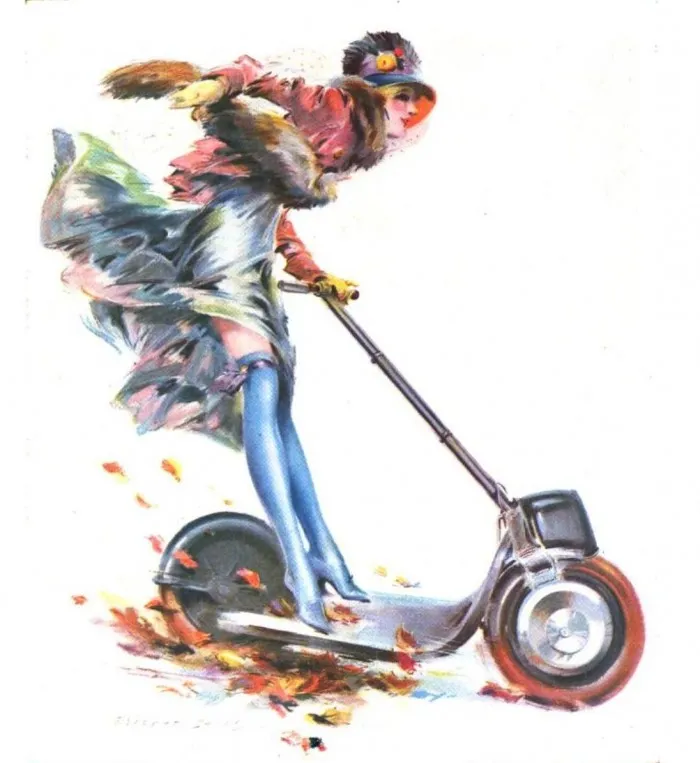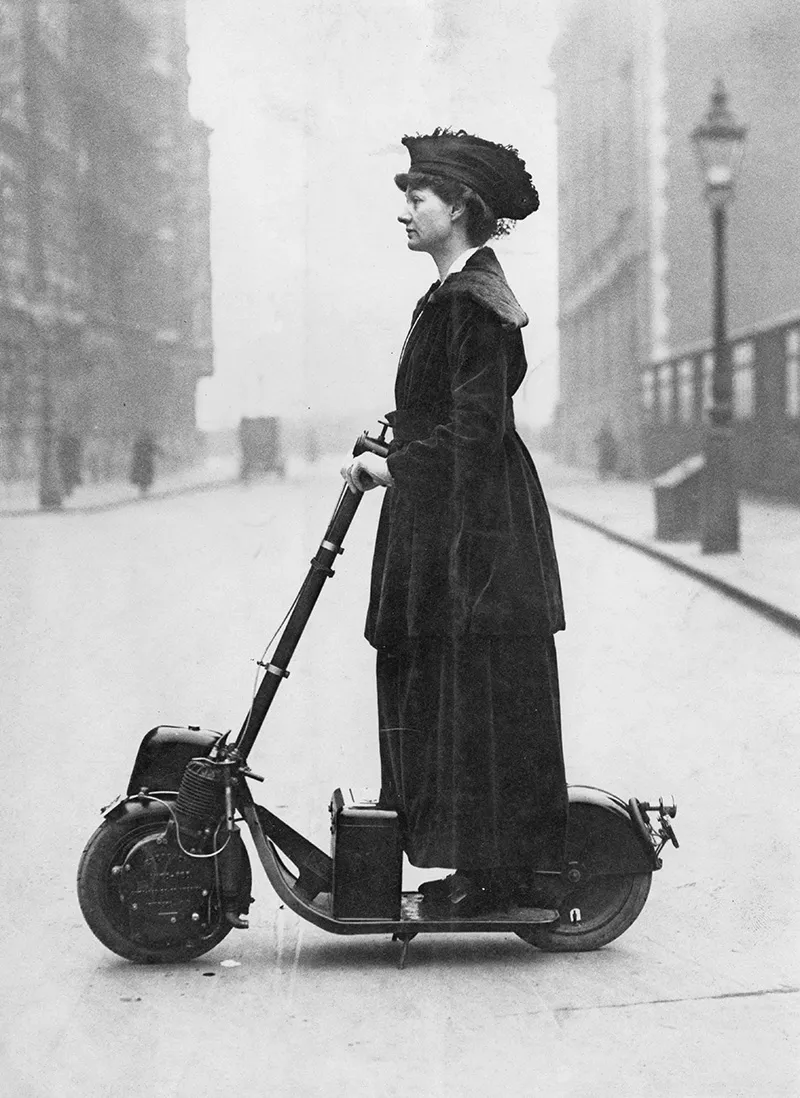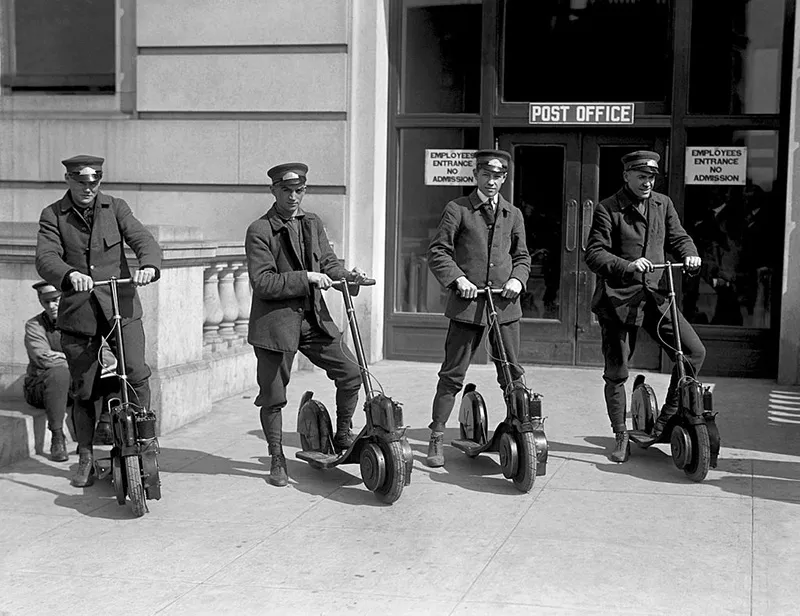The Motorized Scooter Boom That Hit a Century Before Dockless Scooters
Launched in 1915, the Autoped had wide appeal, with everyone from suffragettes to postmen giving it a try
:focal(400x411:401x412)/https://tf-cmsv2-smithsonianmag-media.s3.amazonaws.com/filer/a4/96/a496c00e-9ec9-44ce-a1c9-7797d826597f/autoped-smithsonian.jpg)
Peter Minton was riding his motorized scooter on Rockaway Beach Boulevard when the patrolman served him with a summons to appear in traffic court. The reason: the 16-year-old was operating the vehicle without a driver’s license.
Minton wasn’t zipping along on a Lime, Bird, Skip or Spin. Instead, the news item dates back to July 1939, when the motorized scooter was first booming in the U.S. Long before Silicon Valley companies swarmed American cities with their cheap rideshare scooters, the Autoped disrupted it all first when it hit the pavement around 1915.
The Online Bike Museum explains that the Autoped, the first mass-produced motorized scooter ride in the U.S., was “[e]ssentially an enlarged child’s scooter with an engine mounted over the front wheel.” Though some reports claimed it could reach speeds of 35 miles per hour, the steering column operated the clutch and brake, which the museum noted made the ride “unsteady” when it pushed 20 mph. Later, a battery-operated version of the Autoped was made available when the Everready Battery Company bought the outfit.
The concept of the scooter stretches back at least a century before to 1817 and Baron Karl von Drais de Sauerbrun of Germany. After he debuted his early two-wheeled, human-powered ride, the velocipede concept was quickly spun off into bicycles, tricycles and kick scooters. Give or take a few decades, the transportation was being motorized, too, with rear treadle drives popping up in Scotland around the 1840s, according to the Encyclopedia Britannica. Come the turn of the 19th century, battery-powered machines were also entering into the fold; Ogden Bolton Jr. was issued a U.S. patent for his battery-powered bicycle in 1895.
But the Autoped (and its first generation predecessor, the Motoped) can be seen as “the true ancestors of the modern motor scooter,” according to the museum. It came at a time when there were scarcely any safety regulations for motorized vehicles on the road. While Connecticut created the first statewide traffic law to regulate motor vehicles in 1901 and New York introduced drunk driving laws roughly a decade later, by the time the Autoped rolled out, traffic lights were still 15 years away from being introduced.

The patent for the design of the “self-propelled vehicle” went to inventor Arthur Hugo Cecil Gibson, though it appears that Joseph F. Merkel, the designer behind the Flying Merkel motorcycle, helped significantly in the creation of the final product. The rides were manufactured through the Autoped Company of America, first incorporated in 1913, which set up shop in Long Island City in Queens, New York, in the fall of 1915.
At first, the cycling press of the day wrote off the Autoped as “a ‘freak’ vehicle,” according to New York State Museum senior historian emeritus Geoffrey N. Stein. But the Autoped hung around longer than expected, perhaps because it intrigued a wide tent of users. As its advertisement copy makes clear, it was marketing broadly:
“The Autoped is an ideal short distance conveyance for business or professional men or women to and from their places of business; for women to go shopping or calling; for physicians to make their regular daily calls or to answer hurry calls; for the older children to go about quickly for outing or school; for servants when they are sent on errands; for grocers, druggists and other merchants for quick delivery purposes; for commercial salesman to call on the trade; for employees to ride to and from work; for collectors; repairmen; messengers, and for anybody else who wants to save money, time and energy in going about. All will enjoy the comfort and pleasure of AUTOPEDING.”

Just as their modern-day equivalents have come under fire for being toys of the wealthy elite, the Autoped’s marketing certainly carried a bit of a class element. An advertisement that ran in Puck magazine in 1916—“Look out for the Autoped girl”— pictured an illustration of a fashionable well-to-do white woman in a fabulous hat, a fur wrapped around her neck. The copy was clearly after a specific demographic: “If you were the sort of person who did your gift shopping in the 1916 equivalent of the Neiman Marcus Christmas catalog (Hammacher Schlemmer, maybe), an Autoped was on your list,” explains Hemmings Daily, the blog of the classic car marketplace.
But the Autoped wasn’t just a plaything of the rich. Just like the bicycle before it, the advent of the motorized scooter promoted a level of freedom and mobility for women that gave the messaging “Look out for the Autoped girl,” more heft. Over at Mashable, Chris Wild recounts the story of the “suffragette on a scooter,” Lady Florence Norman, who rode her Autoped to work in central London. Meanwhile, Amelia Earhart, the famous aviatrix, appeared in multiple photographs with the Autoped around California, even after it stopped being manufactured around 1921. With Earhart on it, it’s easy to imagine why the caption to one of those photographs reads: “In the near future, we are told, no one will walk at all.”

Businesses also gave the Autoped a try. The best example might be the New York Postal Service, which used the slim rides to deliver mail. To the frustration of police, delinquents saw their own window of opportunity in the nimble machinery, repurposing them as getaway vehicles. “Groups of rowdy youth were soon terrorizing the boroughs of Brooklyn, Queens and Manhattan,” writes the Online Bike Museum, highlighting the intriguingly named Long Island Bogtrotters. Led by the “legendary” Fat Burns, the museum notes the group even made a Yonkers Grand Prix with the machines. “[T]he first and last” of such an event.
Still, like the ubiquitous packs of tourists traveling via Segway today, the majority of the machines were used for recreation. Stein features one gleeful picture of two women taking part in an impromptu Autoped race on the sand in Long Island that had been snapped for a 1916 Motorcycle Illustrated issue. California businesses, the historian noted, had purchased 50 machines by 1917 so they could be "rented out at the beach resorts next season.”

But just as dockless scooters today struggle to recuperate costs—while there’s been billions invested in the eco-friendly startups, a profitable business model remains a work-in-progress to put it diplomatically—the Autoped’s lifespan was ultimately cut short by its bottom line. Erwin Tragatsch, author of The Illustrated Encyclopedia of Motorcycles, tells Stein that "like all other scooters of that period, the Autoped was not a commercial success." Experts he spoke to suggested the problem may have had to do with the need for the device, which was more expensive than a bicycle but didn’t offer the seated comfort of a motorcycle.
The Autoped was, perhaps, just a little ahead of its time with what it was offering. After the Great Depression hit, the Cushman company, which got its start making engines in the early 1900s, picked up where its predecessor left off, finding new utility in the ride among those pinching pennies. Stuck with a surplus of Husky engines as the Depression lingered, the company got creative. In 1936, it debuted the Cushman Auto-Glide. “A byproduct of the 1929 catastrophe, the scooter was lauded for being thrifty,” Cycle World magazine later wrote because of its price point and gas needs. One brochure went as far as to claim driving an Auto-Glide was “NO COST AT ALL,” adding, “Why, it’s actually cheaper than walking.”
Ultimately, the Auto-Glide and its competitors were dogged by the same kinds of regulations that sent Peter Minton to traffic court in 1939. The years of “driving dangerously” of the early 1900s were changing as lawmakers attempted to get ahold of the early age of the automobile.

“Little attention has yet been paid to the right of any man to drive a car,” the New York Times had bemoaned in 1907, suggesting that “Something akin to the French system, which is the ideal plan of licensing drivers, furnishing them with official cards with the penalty of revoking the license in addition to a jail sentence for a second or third serious offense,” was needed in the U.S. By the 1930s, the framework of such a system had arrived.
“It says much that Cushman faced serious financial problems again when the U.S. government introduced more stringent traffic laws for young riders,” Josh Sims comments in Scootermania, which chronicles the evolution of the ride.
It’s easy to see how the times we’re living in now echo back to the first scooter boom. “Today’s startups are promoting their products by following the same playbook as cars: get them on the street, and figure out how to regulate them afterward. That strategy also propelled Uber and Lyft to multi-billion dollar valuations,” Michael J. Coren wrote for Quartz in 2018. But it remains unclear how the vehicles will fare as lawmakers once more play catch up to regulate the rides this go around.